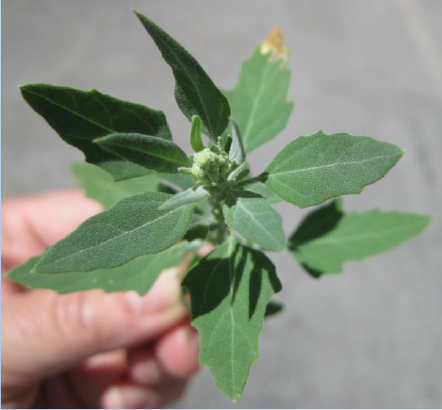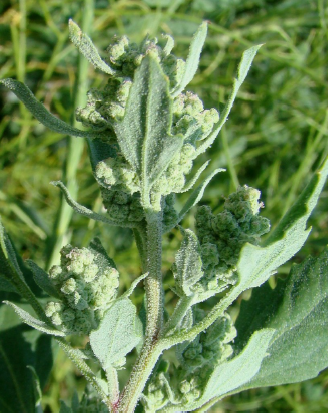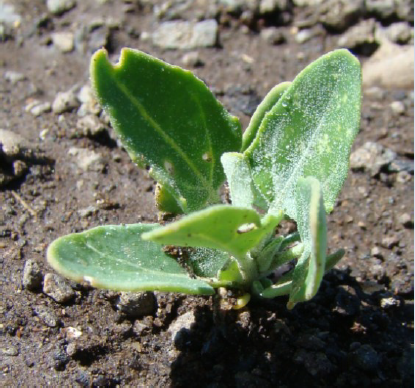Other common names
Lambsquarters, poor man’s spinach, white goosefoot, white pigweed, wild spinach, mealweed, others
Scientific name
Chenopodium album
Family
Chenopodiaceae
Description
Common lambsquarters is a common weed that grows a ground-hugging rosette form sometimes tinged with purple, and then grows into a bushy plant up to 5 feet tall. It blooms during the summer. While often considered edible, it can accumulate chemicals called oxalates that can be toxic if enough is eaten.

Typical plant growing in a disturbed site. Photo by S. Donaldson.
Leaves
Light greenish-gray alternately attached leaves are triangular or goosefoot-shaped. The top is usually covered in a whitish powdery substance, and the underside is whitish. Lower leaves are larger and upper leaves are smaller.

The leaves are spear-shaped and covered with a whitish substance. Photo by S. Donaldson.
Stems
Branched; sometimes have purplish-red stripes and grooves.
Flowers
Small and greenish-gray with no petals; found at the tips of the main stem and branches and in leaf axils (see photo page 2).

The small, greenish flowers are difficult to see and occur in clusters in the leaf axils. Photo by W. Hanson Mazet.
Roots
Grows a taproot with fibrous lateral roots.

Note the whitish powdery substance on the seedling leaves. Photo by W. Hanson Mazet.
Native to
Europe
Where it grows
Roadsides, pastures, gardens, landscaped areas and other disturbed sites.
Life cycle
Summer annual
Reproduction
Reproduces by seed; prolific seed producer
Control methods
Common lambsquarters is best controlled when young. This can be difficult, as seeds may continue to sprout throughout the summer.
Mechanical
Dig, hoe or pull young plants. Plants usually don’t survive mowing or clipping.
Cultural
Plant desirable vegetation to help suppress the lambsquarters. Corn gluten meal has been shown to help reduce survival of sprouting seeds.
Biological
None commercially available.
Chemical
Try broadleaf selective herbicides such as 2,4-D and dicamba on young plants, or use glyphosate (nonselective). Dicamba can persist for several months and may damage desirable plants in the area treated. Pre-emergence herbicides can be used to manage existing seed banks.
References
DiTomaso, J.M. and E.A. Healy. 2007. Weeds of California and Other Western States. University of California Publication 3488.
HPIPM. 2009. Common lambsquarters. Bugwood Wiki
Peachy, E. (editor). 2011. Pacific Northwest Weed Management Handbook. Oregon State University, PNW.
Whitson, Tom D. (editor). 2002. Weeds of the West. University of Wyoming, Jackson, Wyoming.
USDA-NRCS Plants Database. 2011. PLANTS profile for Chenopodium album, USDA.
UC IPM. 2010. Common lambsquarters. IPM.
Donaldson, S. and Hanson Mazet, W.
2011,
A Northern Nevada Homeowner’s Guide to Identifying and Managing Common Lambsquarters,
Extension | University of Nevada, Reno, FS-11-63


